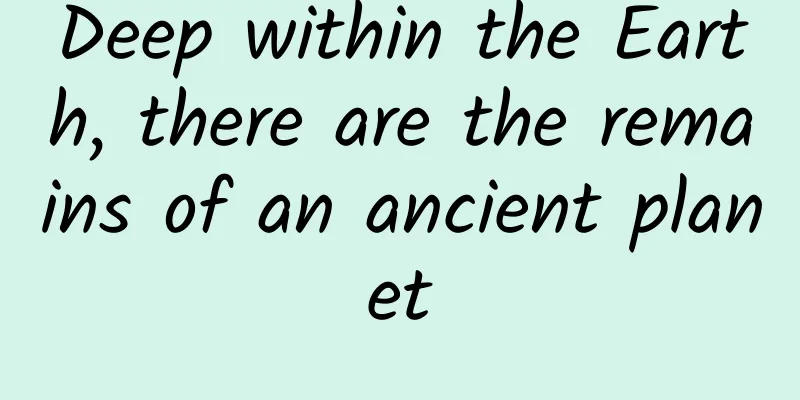Deep within the Earth, there are the remains of an ancient planet

|
I believe many people have heard such a story. About 4.5 billion years ago, a Mars-sized protoplanet called Theia collided violently with the young proto-Earth. The debris ejected by this collision eventually gathered together to form the moon . Although this is the mainstream theory of the formation of the moon, it is often challenged because of some difficult-to-explain details. For example, scientists have never found traces of Theia in the asteroid belt or meteorites. So, where did all the other impact debris go besides the material that formed the moon? In a new study published in the journal Nature on November 1, 2023, researchers believe that most of Theia's material was absorbed by the young Earth ! What is going on? Let's start with the unusual discoveries inside the Earth. Abnormal matter inside the earth We live on the Earth's crust , a thin layer of solid rock; at the center of the Earth is the **core**, which is made mostly of iron and nickel; and between the crust and the core is the **mantle**. In the 1980s, geophysicists were surprised to find that at the bottom of the mantle near the core, there were two huge, mysterious abnormal material bodies , one under the African continent and the other under the Pacific Ocean. The density of these two anomalous bodies is slightly higher than that of the surrounding environment, which indicates that they may be composed of different proportions of elements compared to the rest of the mantle. We know that the propagation speed of seismic waves is different in different materials, and when seismic waves pass through these anomalous rock layers that stretch for thousands of kilometers at the bottom of the mantle, the speed of seismic waves will be significantly reduced. Therefore, these two mysterious anomalous bodies are also called large shear wave low-velocity bodies (LLSVPs). LLSVPs have important implications for the evolution of the Earth's mantle, the breakup and assembly of supercontinents, and the structure of Earth's tectonic plates. But the question is, where do they come from? How are they formed? Geophysicist Yuan Qian is the first author of the new paper. He and his collaborators have built different models for the chemical composition of Theia and its impact on the Earth, simulating the interaction between Theia's mantle and the Earth's mantle from the collision to the present. The simulation results confirm that the collision between Theia and the Earth is indeed likely to lead to the formation of LLSVPs and the Moon: The violent impact caused most of the material of Theia to combine with the Earth's mantle . The molten layer of the Earth's upper mantle drew some of the material in and turned it into Earth material. Another part of the material from Theia passed through the molten layer of the Earth's mantle and sank to the bottom of the basically solid lower mantle , where it then gathered and crystallized, eventually forming the two independent LLSVPs that we have detected at the boundary between the core and the mantle today. At the same time, some of the remaining fragments of Theia produced by the impact were thrown into orbit and coalesced into the Moon . The simulations suggest that a large portion of Theia's core (equivalent to 3% of Earth's mass today) remained on our planet, while a large portion of Theia's mantle (about 5% of Earth's mass) was embedded in the upper 1,400 kilometers or so of Earth's mantle. To be further verified However, more tests are needed to further confirm the new research, such as researchers can verify these models by comparing rock samples from the mantle and the moon. The researchers said their next plan is to study what impact these large, low-velocity bodies had on the early evolution of the Earth. They hope that this research will reveal what makes the Earth so unique and even provide inspiration for understanding the formation and habitability of exoplanets outside the solar system. This article is a work supported by Science Popularization China Starry Sky Project Team: Principle Reviewer: Zhang Yuxiu (School of Earth and Planetary Sciences, Chinese Academy of Sciences) Produced by: China Association for Science and Technology Department of Science Popularization Producer: China Science and Technology Press Co., Ltd., Beijing Zhongke Xinghe Culture Media Co., Ltd. #Reference source: https://www.nature.com/articles/s41586-023-06589-1 https://www.caltech.edu/about/news/the-remains-of-an-ancient-planet-lie-deep-within-earth https://english.cas.cn/head/202310/t20231026_394367.shtml https://www.nature.com/articles/d41586-023-03385-9#ref-CR2 |
Recommend
Baidu search oCPC four-stage optimization direction
Regarding the four-stage optimization directions ...
Sweetener, no rotting, light taste? Five questions about Sunshine Rose grapes, all you care about is here →
When a person is famous, there are many controver...
WeChat users who transfer more than 5,000 yuan for 10 consecutive days will be required to upload their ID cards as required
The advent of the Internet era has made mobile pa...
Shocking! 400 camera accounts sold for 150 yuan... Pay attention to privacy and security!
Since the beginning of this year, the Cyberspace ...
Soul advertising, Soul advertising forms
Although the top promotion platforms are now famo...
Sun Jing Victoria's Secret Body Sculpting 14-day Family Training Camp Waist and Abdomen Shaping
Sun Jing Victoria's Secret Body Sculpting 14-...
Learn movie editing in 7 days on Tik Tok (including a full set of video tutorials), and get a little money-making trick every day!
I don’t need to say much about the Tik Tok movie ...
Features and display forms of Phoenix.com splash screen ads and information flow ads
The threshold for advertising on Phoenix.com is l...
Animals are infected with the new coronavirus again. How can humans defeat the new coronavirus?
Recently, the Mongolian National Center for Zoono...
The pictures downloaded from WeChat cannot be Photoshopped! Teach you how to make PS support WebP
Many friends have found that the pictures dow...
The reasons and solutions for the restricted traffic of Tik Tok!
With the advent of 5G in 2019, short videos, as t...
Why are cases still high as the weather gets warmer? Does temperature affect the activity of the virus?
It is the season of spring again, when flowers bl...
Suifengshuo: The dark side of finance Baidu Cloud download
Suifeng said: Introduction to the black scene res...
To deal with "double positive", how to choose among the 6 domestically marketed new coronavirus oral drugs?
Recently, topics related to the novel coronavirus...
Are greenhouse strawberries out-of-season fruits? Are they big because they were given hormones? The truth is →
Image courtesy of Visual China Strawberries have ...









